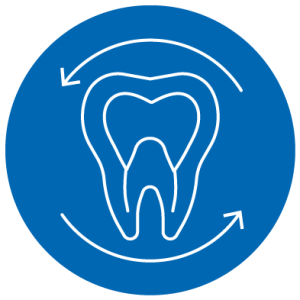treatments
our services
We offer endodontic treatments according to the best available scientific data.

DIAGNOSIS OF PAIN
Prior to treatment, the clinician has to have a clinical diagnosis. This is obtained with a complete examination. When a patient is in pain, it can be challenging to find the source of the pain. This is when the multiple endodontic tests along with a radiographic examination are meticulously applied. Once the trigger of the pain determined, a clear diagnosis can be determined and a treatment can be applied if necessary. What appears to be dental pain can actually be a non-odontogenic pain and therefore a root canal treatment would not solve the problem. Endodontic intervention is in some cases contraindicated.
ROOT CANAL TREATMENT
A root canal is usually recommended when the pulp is infected with bacteria from the mouth or following an accidental dental trauma. Without a treatment, this infection can become problematic and cause pain and swelling. The procedure consists on making a small access through the tooth so as to clean inside the canals of the tooth with special instruments. The nerves and the debris are removed and the canals are then filled with an obturation material. A filling or a crown are then placed (ideally as soon as possible) so as to reestablish the function of the tooth. A root canal allows the tooth to retain its initial function and esthetics.


ROOT CANAL RETREATMENT
Even though root canals have a high success rate, sometimes due to persistance of bacterial contamination or recontamination a root canal needs to be redone. In those cases, a similar procedure to the initial root canal therapy needs to be applied. The main difference and one of the complicating factors in the root canal retreatment procedure is the retrieval of the root canal obturation material. Careful consideration is given to improve upon the reasons that brought the failure of the initial root canal. A 3D image is sometimes beneficial in root canal retreatment cases.
APICAL SURGERY
The apical surgery, or what is sometimes called an apicoectomy, is a supplemental option or an alternative to the root canal retreatment. This minor surgery removes the persistant infection while cleaning the tip of a root of the tooth. A small incision is made along the gums and then temporarily retracted. The apex of the root is slightly sectioned and the canal is cleaned in the revers direction. A biocompatible material is then applied so as to seal the tip of the root. The gums are thereafter sutured. A swelling along with some discomfort are to be expected 2 to 4 days following the surgery. A follow-up and suture removal appointment will be given to you 5-7 days after the apical surgery. Estimate that the healing of the gum is complete usually after a few weeks.


INTENTIONAL REIMPLANTATION
Following an unsuccessful attempt at the root canal therapy, and if the apical surgery is not an option, an alternative and less known method is the intentional re-implantation. The procedure implies the atraumatic extraction of the tooth, so as to keep the tooth in one piece and functional. Once the extraction completed, the rest of the procedure ressembles the apical surgery. The tip of the tooth is resected and the canal is cleaned and filled with the same biocompatible material as used for the apical surgery. Once these steps are applied, the tooth is re-implanted in the extraction socket and stabilized. The healing is often very fast and the success rates are excellent.
DENTAL TRAUMA
There are multiples types of dental traumas. They vary in severity and range from a minor coronal tooth fracture, to a luxation of the whole tooth and even can be avulsed outside the mouth (meaning the tooth is “expulsed” out of the mouth by the force of the hit). In the majority of cases, the clinical intervention is imminent so as to save a tooth. The therapeutical intervention ranges from a simple small filling to the stabilisation of the tooth with a splint to a root canal therapy sometimes triggered towards immature teeth (as most of dental traumas occur in younger patients).
For any dental trauma emergencies to a child, adolescent or adult, please contact us immediately during the day at 514-344-3636 the dental clinic at Endodontie Lotus or for non regular hours on the emergency phone number found on our answering machine. If not, for any emergencies to a child or an adolescent, please go to the emergency of Saint-Justine Hospital.


INTERNAL BLEACHING
The decollation of an anterior tooth is a cosmetic problem that can be cumbersome. Sometimes an external bleaching procedure is not enough to render an aesthetic result. While crowns and veneers can also resolve the issue, a less invasive but still aesthetic procedure can be used in teeth with a root canal – the internal bleaching.
Internal bleaching implies the application of a bleaching product inside the small access that had been made previously made for the root canal-ed tooth. The material is placed inside the tooth and covered by a temporary restoration for usually a week. In the majority of cases, one unique application is enough to render the desired results. Cases with sever decoloration require multiple application so as to gain an aesthetic result.




